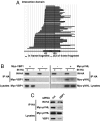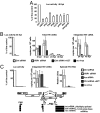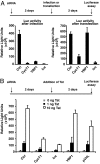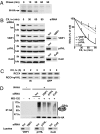von Hippel Lindau binding protein 1-mediated degradation of integrase affects HIV-1 gene expression at a postintegration step
- PMID: 17698809
- PMCID: PMC1959430
- DOI: 10.1073/pnas.0705162104
von Hippel Lindau binding protein 1-mediated degradation of integrase affects HIV-1 gene expression at a postintegration step
Abstract
HIV-1 integrase, the viral enzyme responsible for provirus integration into the host genome, can be actively degraded by the ubiquitin-proteasome pathway. Here, we identify von Hippel-Lindau binding protein 1(VBP1), a subunit of the prefoldin chaperone, as an integrase cellular binding protein that bridges interaction between integrase and the cullin2 (Cul2)-based von Hippel-Lindau (VHL) ubiquitin ligase. We demonstrate that VBP1 and Cul2/VHL are required for proper HIV-1 expression at a step between integrase-dependent proviral integration into the host genome and transcription of viral genes. Using both an siRNA approach and Cul2/VHL mutant cells, we show that VBP1 and the Cul2/VHL ligase cooperate in the efficient polyubiquitylation of integrase and its subsequent proteasome-mediated degradation. Results presented here support a role for integrase degradation by the prefoldin-VHL-proteasome pathway in the integration-transcription transition of the viral replication cycle.
Conflict of interest statement
The authors declare no conflict of interest.
Figures




Similar articles
-
Cellular TRIM33 restrains HIV-1 infection by targeting viral integrase for proteasomal degradation.Nat Commun. 2019 Feb 25;10(1):926. doi: 10.1038/s41467-019-08810-0. Nat Commun. 2019. PMID: 30804369 Free PMC article.
-
Yeast two-hybrid detection of integrase-host factor interactions.Methods. 2009 Apr;47(4):291-7. doi: 10.1016/j.ymeth.2009.02.002. Epub 2009 Feb 20. Methods. 2009. PMID: 19232540
-
Genomic organization and chromosomal localization of the human CUL2 gene and the role of von Hippel-Lindau tumor suppressor-binding protein (CUL2 and VBP1) mutation and loss in renal-cell carcinoma development.Genes Chromosomes Cancer. 1999 Sep;26(1):20-8. Genes Chromosomes Cancer. 1999. PMID: 10441001
-
Atlas on substrate recognition subunits of CRL2 E3 ligases.Oncotarget. 2016 Jul 19;7(29):46707-46716. doi: 10.18632/oncotarget.8732. Oncotarget. 2016. PMID: 27107416 Free PMC article. Review.
-
HIV-1 integration: an interplay between HIV-1 integrase, cellular and viral proteins.AIDS Rev. 2005 Jan-Mar;7(1):26-43. AIDS Rev. 2005. PMID: 15875659 Review.
Cited by
-
Augmentation of reverse transcription by integrase through an interaction with host factor, SIP1/Gemin2 Is critical for HIV-1 infection.PLoS One. 2009 Nov 13;4(11):e7825. doi: 10.1371/journal.pone.0007825. PLoS One. 2009. PMID: 19915660 Free PMC article.
-
NHEJ pathway is involved in post-integrational DNA repair due to Ku70 binding to HIV-1 integrase.Retrovirology. 2019 Nov 6;16(1):30. doi: 10.1186/s12977-019-0492-z. Retrovirology. 2019. PMID: 31690330 Free PMC article.
-
Cellular TRIM33 restrains HIV-1 infection by targeting viral integrase for proteasomal degradation.Nat Commun. 2019 Feb 25;10(1):926. doi: 10.1038/s41467-019-08810-0. Nat Commun. 2019. PMID: 30804369 Free PMC article.
-
Optimization of the piggyBac transposon using mRNA and insulators: toward a more reliable gene delivery system.PLoS One. 2013 Dec 3;8(12):e82559. doi: 10.1371/journal.pone.0082559. eCollection 2013. PLoS One. 2013. PMID: 24312663 Free PMC article.
-
Retroviral DNA Integration.Chem Rev. 2016 Oct 26;116(20):12730-12757. doi: 10.1021/acs.chemrev.6b00125. Epub 2016 May 20. Chem Rev. 2016. PMID: 27198982 Free PMC article. Review.
References
Publication types
MeSH terms
Substances
LinkOut - more resources
Full Text Sources
Other Literature Sources
Molecular Biology Databases
Research Materials

